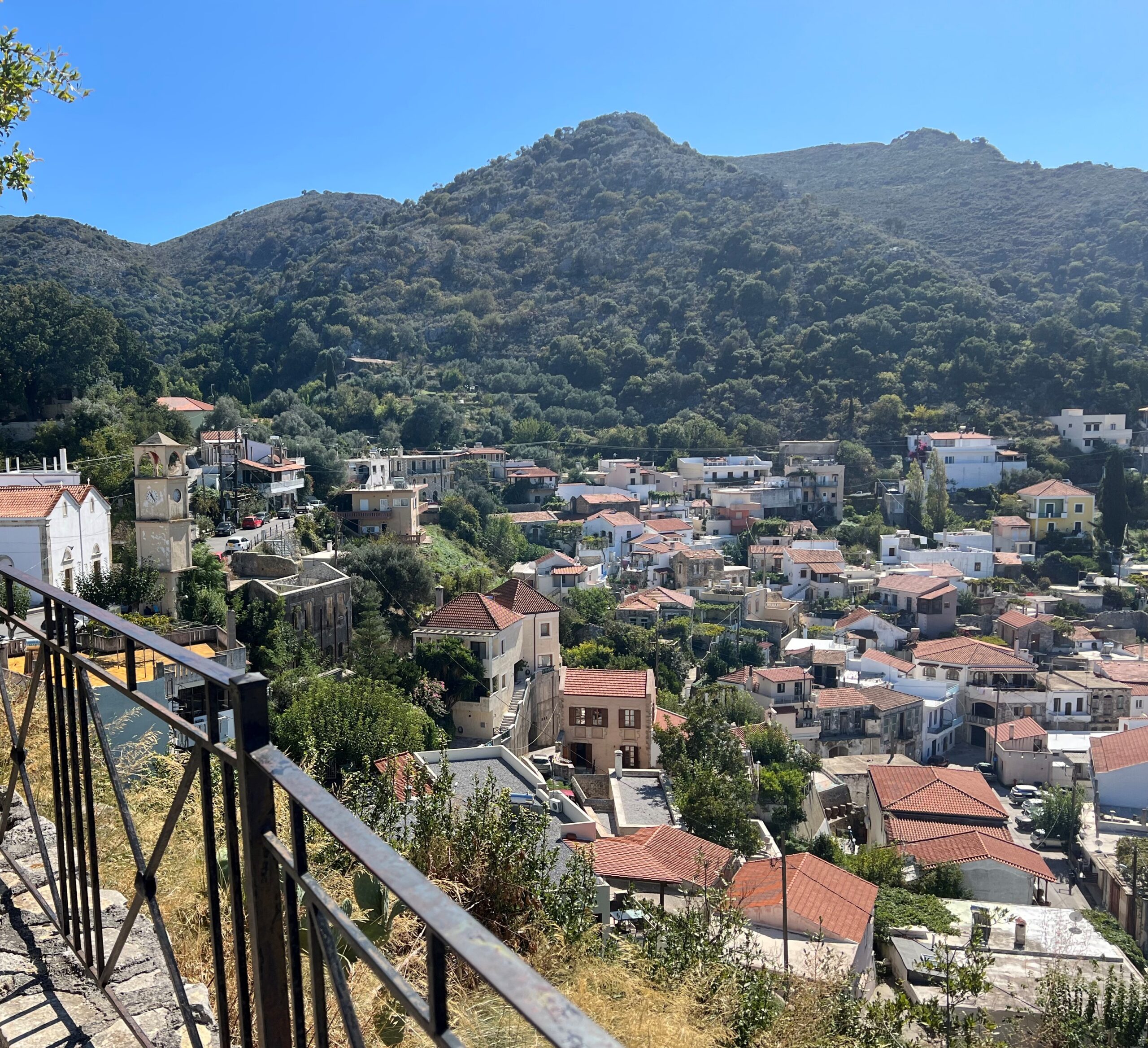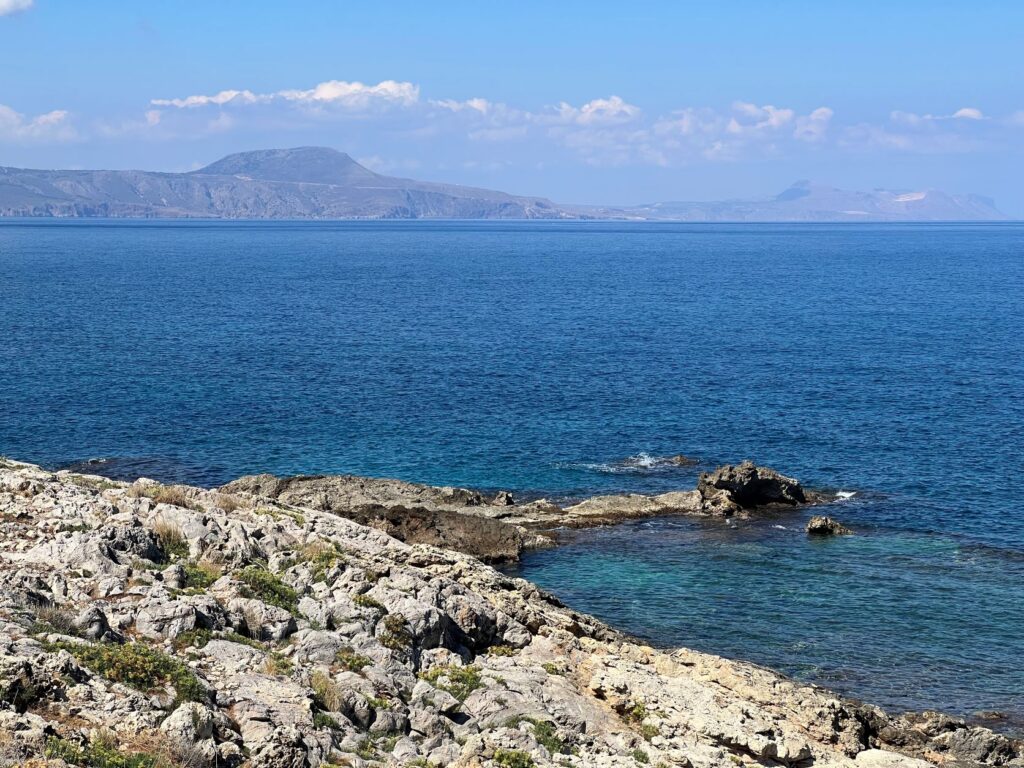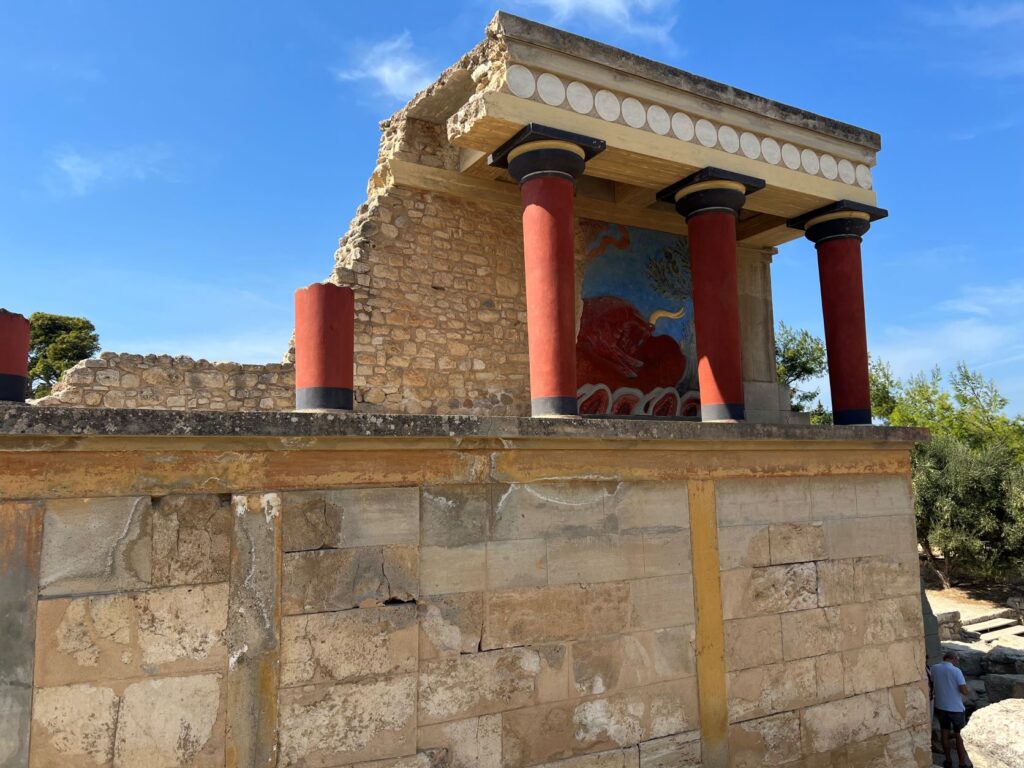I am in a magical place, an island in the southern Mediterranean at the crossroads of cultures – Minoan, Roman, Greek, Turkish. I see this mixture almost everywhere I go, where there are visually significant remnants of history, a lively welcoming culture and delicious food. I am visiting Norwegian friends in their vacation home, aptly named Villa Eureka, for its hillside views within walking distance of the coast.
On my first full day here, I woke up to the sun climbing over the high ridge to the east and glancing down across the terraced garden of olive and pomegranate trees, flowers and herbs. We wiped the light dusting of Sahara sand from the outdoor dining table and placed cushions on the rattan mats. Bees were exploring curiously all around amid the pots of bougainvillea, hibiscus and rosetta succulents and blooming jasmine-like shrubs.
I could be on a Caribbean island, or a mountain in south Florida (if they existed) or Palm Springs without an ocean. The stucco villas with floor-to-ceiling windows in this community (“Gerani Cave Village”) on the northwest-central coastline are designed for living outdoors, with reinforcing walls of yellow limestone, grape arbors, palm trees, swimming pools and spacious decks. The jacuzzi here is named “Spa Archimedes,” in a nod to the scientist who exclaimed “Eureka!” Our views hooks around to Chania (pronounced “Hania”), where I arrived on a quick 50-minute flight from Athens. The Greek island of Crete is 2.3 times the length of Long Island and about 3000 square miles, the fifth largest in the Mediterranean. More southern than parts of Morocco, Algeria and Tunisia, it is a strategic crossroad of cultures and occupations – Minoans, Greeks, Romans, Saracens, Venetians, more 200 years of Turkish rule in the Ottoman Empire until the start of the 20th century and the Germans during World War II.
Mountainous (up to 8,000 feet), dotted with boulder landscapes, olive orchards and scrub greenery, its somewhat barren terrain is the work of unruly goats that roam and graze everywhere (and are gated against). Steep slopes and caves line a glistening aquamarine shoreline with both wide and hidden beaches. Today we will attend our friends’ annual “Raki” party, marked by the backyard distilling of white grapes from the mountain vineyards into a drink that is from 30 to 60% alcohol. My hosts call today’s party the making of “Cretan moonshine.” I can manage a sip, that’s all, as it reminds me of the harsh grain alcohol from college fraternity parties. But the clear Raki is a symbol of friendship and appears everywhere, often as a thank you with dessert at a restaurant and, one day, as a sign of appreciation from a jewelry store owner after the bill was paid!
We drive across the mountain to Argyroupoli (ancient Lappa, 3rd century BC), built high on a hillside with Roman, Venetian and Byzantine homes, churches and other remains still under restoration, and roaring springs below. Numerous tiny roadside Greek Orthodox chapels mark fatal accidents along the curvy steep terrain. At the archway into the old village, the mayor’s daughter is chatting with a friend and warmly greets us. Excavations reveal a Roman floor mosaic, old Roman bath, medallions with inscriptions and the Roman gate with the inscription, “All Things in This World Are Smoke and Shadow.” Lappa was destroyed by the Saracens in the 9th century and today is protected from development that is not historically authentic.
Our host has restored a more than 200-year multi-story home that once was a vermin-infested ruin into a charming artisanal villa for vacation rentals. Outside in the terraced garden a handful of men tend the homemade distillery, stoking the fire with dense gray logs from olive trees, frequently wiping down the copper pipes to cool the brew. An in-law grills dozens of large pork cutlets and hamburgers for the 40-some guests, extended family and friends from infants to retirees in an informal colony of Norwegians who live here seasonally. Before the end of the cooking, three goat heads appear on the grill for roasting, savored for their flavorful cheeks and other fleshy parts. There are piles of hamburgers for the kids.
When the “Raki” is ready, there is dancing and some tasting (always in one gulp from a shot-size glass); I stick to pleasant light white wine. On the patio, an electric keyboardist and acoustic lute player accompany a sultry singer with traditional and popular Greek music. Lucky for us, Silver Koulouris, who was in the popular Greek band Aphrodite’s Child with the late Demis Roussos, is playing the long-necked Cretan lute or “bouzouki.” I record their extended rendition of “Never on Sunday,” the theme from Zorba the Greek, and a prized souvenir of this special occasion.




